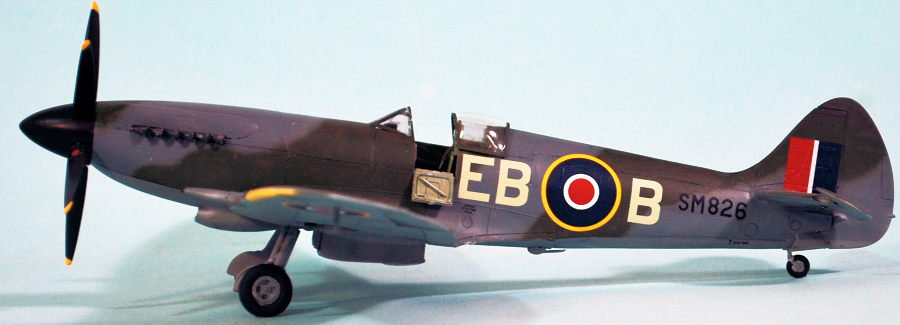
Airfix 1/48 Spitfire FR.XIVE
| KIT #: | A05135 |
| PRICE: | $31.95 |
| DECALS: | Two options |
| REVIEWER: | Tom Cleaver |
| NOTES: | Mild conversion |

| HISTORY |
It's a strange but interesting fact that the only "built for that specific powerplant" Spitfire to achieve a large production run was the Mk.I; while there were several other Marks specifically designed to make maximum benefit of the additional power of the later Merlins and then the Griffons, in each case the "interim" type cobbled together to bring the additional performance operational as soon as possible was the version that saw the most widespread production. This began with the Mk.V, which was essentially a beefed-up Mk.I airframe to take advantage of the Merlin 45's additional 400 h.p. This was followed by the Mk.IX, a beefed-up Mk.V to take advantage of the Merlin 60 series while the Mk.VIII was being designed to take maximum advantage of this engine. The last was the Mk.XIV, a beefed-up Mk.VIII airframe to use the Griffon.
Development of the Spitfire to use the more powerful Rolls-Royce Griffon engine began in late 1940, with what was first known as the Spitfire IV, which was to use the Griffon II and was known as the Type 337. The airframe involved extensive modification to absorb the additional power; at one time it flew with a mockup of no less than three 20mm cannon in each wing. Before the prototype DP845 flew, it was designated the Spitfire XX to distinguish it from the P.R. Mk. IV. Plans that all XX-series Spitfires would be Griffon-powered were changed when the interim Mk. XII and Mk. XIV types were introduced.
The Mk. XII was an emergency creation to deal with the low-level "tip-and run" raids by Fw-190s and involved mating the Griffon II engine to a Mk. Vc airframe. The more detailed development utilized DP851, which was used to develop the Griffon 61 series. DP851 was further developed into the Spitfire XXI. In order to gain further experience with the Griffon-61, six Mk. VIII airframes, JF316 to JF321 were modified to take the Griffon engine. Experience with these airplanes showed it would be possible to create a Griffon-powered high-altitude air superiority fighter in a faster timeframe than envisioned with the Spitfire XXI by mating the Griffon to the Mk. VIII airframe the way the Merlin-61 had been mated to the Spitfire Vc. Thus, third major development of the Spitfire saw the "interim" type produced in larger numbers and used more widely than the version developed specifically to use the engine change.
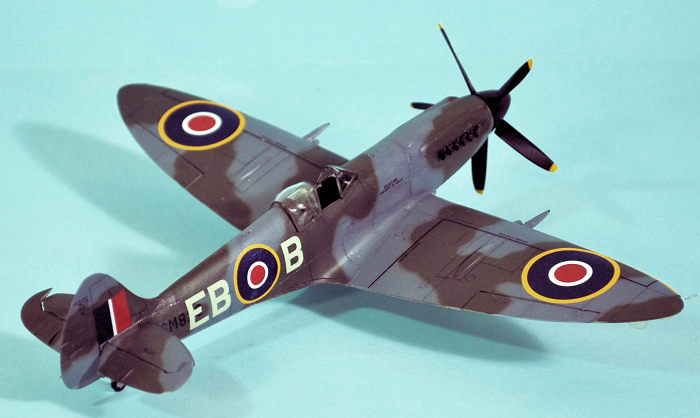 Like the Spitfire V and Spitfire IXC, the Spitfire XIV was an
"interim" type pending production of the "definitive" Spitfire XVIII, which
utilized a "beefed-up" Mk. VIII airframe with larger radiators and first
appeared with the "C" wing. The first squadron to equip with the new type
was 610, a former RAuxAF squadron which had been among to equip with the
original Spitfire. The Mk. XIVs arrived in January 1945. By March, 350
(Belgian) Squadron was also equipping with the type, as was 130 Squadron.
These three would form the Newchurch Wing, which became operational in May
1944, just before the invasion. The thre squadrons were in a long work-up
period to get used to this very different Spitfire, in which the prop
rotated the opposite of all previous Spitfires and required judicious
application of throttle and rudder on takeoff to avoid a torque roll on
takeoff, not to mention the new type was far more nose-heavy than the
Spitfires the pilots were used to. A few fighter sweeps happened before
D-Day.
Like the Spitfire V and Spitfire IXC, the Spitfire XIV was an
"interim" type pending production of the "definitive" Spitfire XVIII, which
utilized a "beefed-up" Mk. VIII airframe with larger radiators and first
appeared with the "C" wing. The first squadron to equip with the new type
was 610, a former RAuxAF squadron which had been among to equip with the
original Spitfire. The Mk. XIVs arrived in January 1945. By March, 350
(Belgian) Squadron was also equipping with the type, as was 130 Squadron.
These three would form the Newchurch Wing, which became operational in May
1944, just before the invasion. The thre squadrons were in a long work-up
period to get used to this very different Spitfire, in which the prop
rotated the opposite of all previous Spitfires and required judicious
application of throttle and rudder on takeoff to avoid a torque roll on
takeoff, not to mention the new type was far more nose-heavy than the
Spitfires the pilots were used to. A few fighter sweeps happened before
D-Day.
The Spitfire XIV was intended to provide high altitude air superiority, to complement the medium-altitude Tempest V. Both these types delayed their entry into air combat over the Continent due to the deployment by the Germans of the Fi-103, the first of which exploded in England two days after the invasion. It was quickly ascertained that the best defense against these robots were standing patrols by the fastest Allied fighters. Over the course of the anti-diver campaign, which only ended when the launch sites in Belgium were overrun by the Allied armies in September 1944, the Spitfire XIV emerged as the most successful of all Spitfire types in destroying the "buzz bombs."
The Mk. XIV arrived on the Continent at about the same time the Jagdflieger were re-equipping with the Langnasen Dora, the Fw-190D-9. The Spitfire XIV had superior performance above 25,000 feet, but most fights over the Western Front happened at lower altitudes. Thus, as had been the case with the Spitfire since the first introduction of the Fw-190, the new version just maintained superiority over the latest 190, with pilot quality being the deciding element.
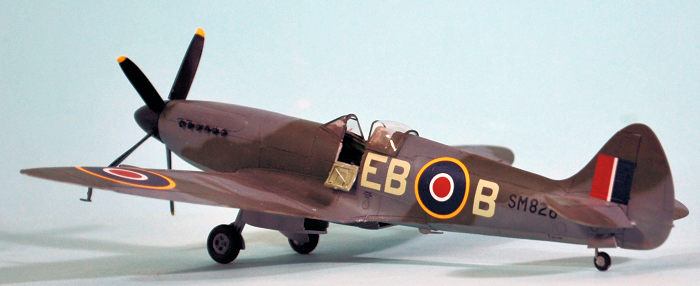 By V-E Day, 20 RAF squadrons were equipped with the Spitfire XIV in
Europe, and the type had arrived in the Southeast Asia Theater. While
Spitfire squadrons quickly re-equipped with the new airplane, the Pacific
War came to a fast end before they could enter combat.
By V-E Day, 20 RAF squadrons were equipped with the Spitfire XIV in
Europe, and the type had arrived in the Southeast Asia Theater. While
Spitfire squadrons quickly re-equipped with the new airplane, the Pacific
War came to a fast end before they could enter combat.
41 Squadron was one of the first units to operate a Griffon Spitfire when they were one of two squadrons equipped with the Spitfire XII in the summer of 1943; they were the only Spitfire XII squadron after 91 Squadron reverted to the Spitfire IX, and continued to operate the Spitfire XII until late September 1944, when they re-equipped with the Spitfire XIV and were transferred to 2 Group on the Continent, where they served till the end of the war. After January 1945, they flew from the Dutch airfield at Twente before moving into Germany in April.
On March 18, 1945, Squadron Leader J.B. Shepherd, who had commanded 610 Squadron prior to their disbandment, took command of 41, which was flying daily armed recon missions over Western Germany and actively involved with the front line units of the Luftwaffe.
On the evening of April 14, 1945, Shepherd led Red Section on an evening patrol. One pilot was forced to abort for engine trouble but the other three pressed on to Bremen, arriving at 1930 hours over Nordholz airfield.Shepherd spotted a Bf-110G-4 of NJG 3 that had just taken off, towing an Me-163 of II/JG 400 to the rocket fighter’s new base at Husum.
Shepherd later reported: I was closing very rapidly, but managed to get a short burst on the Me-110, which went into a left-hand diving turn, flipping on its back and crashing in a field. The Me-163 appeared to break away from the Me-110 and make a wide left turn before diving straight in about three fields away from the Me-110.” In fact, Oberfeldwebel Werner Nelte, the Me-163 pilot, managed to pull out of the dive and crash land successfully. Shepherd was now the only RAF pilot credited with the destruction of an Me-163, though not under its own power. With five already flying the Spitfire XIV with 610, he scored six more victories after these two by V-E Day to be the 4th highest-scoring Griffon Spitfire Ace.
Shepherd was flying Spitfire XIV SM826/EB-B when he scored his double. Tony Gaze scored two more while flying this airplane later that month, along with Pat Coleman who scored one, making SM826/EB-B an “ace” airplane in its own right.
| THE KIT |
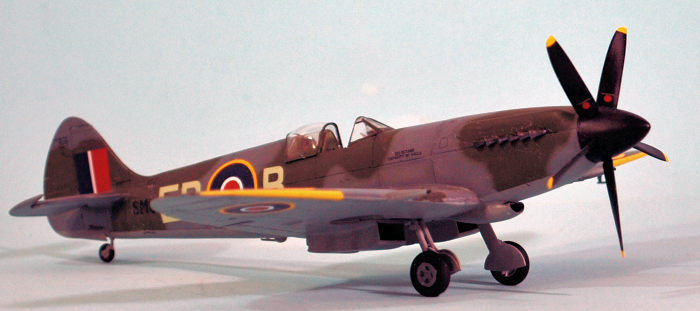 Airfix finally brought out a 1/48 Spitfire XIV in 2019, a “low back”
F.R. XIVe. The kit is excellent and I have reviewed it four times here.
Airfix finally brought out a 1/48 Spitfire XIV in 2019, a “low back”
F.R. XIVe. The kit is excellent and I have reviewed it four times here.
I had this fifth kit I got last year, and it was obvious (by the lack of doing anything with it) that I had done enough “low back” Spitfire XIVs. Since Airfix continues to refuse to modify their PR XIX fuselage and combine it in a box with the rest of this kit and create a “license to print money” for themselves, I decided to solve my desire for a “high back” XIV myself.
| CONSTRUCTION |
My project began when I found an ancient Fujimi Spitfire Vb in the estate sale at the LHS for cheapcheapcheap. It turns out that, comparing the kits, the Fujimi kit is indeed 1/50 (in case you were wondering), but it is interestingly “1/48” as regards the fuselage between the wing and tail. It’s long enough and proper sized to allow to be cut out and combined with the fuselage of the Airfix kit.
As you can see from the photos, once I have sanded things down and rescribed, the project can continue as an “OOB” build of the Airfix kit. I continued construction following my “Easy Construction of an Airfix Spitfire XIV”:
Several modelers have complained about the difficulty of building the kit without use of putty and with loss of detail. There is a very easy way to assemble this kit, such that one will have perfect fit and will use no putty or other filler in the process. Here it is:
1. Before assembling the fuselage, glue some Evergreen strip inside along the lower join line for the gas tank. Assemble the fuselage without attaching the cockpit. This allows you to work the fit of the gas tank to the fuselage from inside and out to get a perfect fit. If you take care in attaching the fuselage halves, you will only have to scrape down the centerline joint to have a smooth result. Before attaching the fuselage halves, cut open the side hatch if you want to pose it open on the finished model.
 2. Assemble the cockpit. Cut off the ferschlugginah “gun sight” and
make a Mk.14 sight, which is easy since it’s a cube with an adjusting wheel
on either side. All Spitfire XIVs used it and it solves the one “mistake” in
the kit. (There are photos of the gunsight to be found on the net, google
“photos of Mark 14 gyro gunsight”) I only used Eduard photo-etch seatbelts,
the rest of the cockpit looks fine when it’s viewed inside the fuselage.
2. Assemble the cockpit. Cut off the ferschlugginah “gun sight” and
make a Mk.14 sight, which is easy since it’s a cube with an adjusting wheel
on either side. All Spitfire XIVs used it and it solves the one “mistake” in
the kit. (There are photos of the gunsight to be found on the net, google
“photos of Mark 14 gyro gunsight”) I only used Eduard photo-etch seatbelts,
the rest of the cockpit looks fine when it’s viewed inside the fuselage.
3. Insert the cockpit into the fuselage, it will “click” into position, then glue it in place.
4. Assemble the main gear wells to the lower wing part, then glue the lower wing to the fuselage.
5. Carefully make sure that the inner edge of the upper wing part will fit perfectly to the fuselage, smoothing off the sprue nubs. Attach the upper wing by starting with the wing-fuselage joint, then glue the upper part to the lower.
6. Attach the horizontal stabilizer. Cut the elevators apart. Attach the plug in the vertical fin, then attach the elevators as you wish them posed.
7. Assemble and attach the radiators and housings and the carburettor intake. If you flood the area where these parts will be attached with liquid glue, it will fill any gaps and you will not need putty anywhere.
You now have a perfectly-assembled model, ready for paint.
| COLORS & MARKINGS |
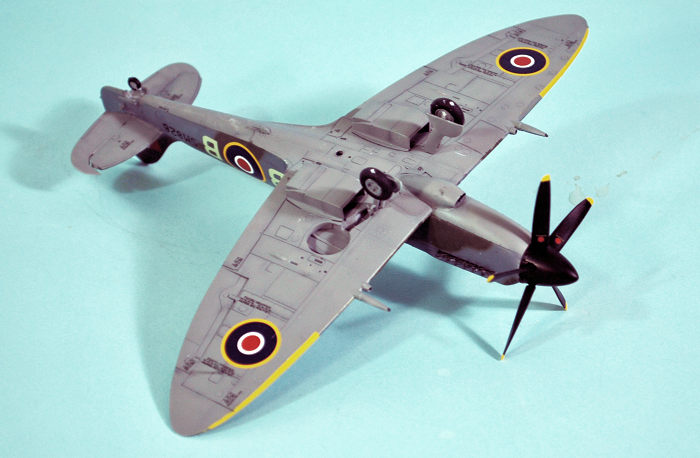 The model was painted using Tamiya XF-81 RAF Ocean Grey, XF-82 RAF
Dark Green and XF-83 RAF Sea Grey Medium, freehanded with my Paashe-H using
a #1 tip.
The model was painted using Tamiya XF-81 RAF Ocean Grey, XF-82 RAF
Dark Green and XF-83 RAF Sea Grey Medium, freehanded with my Paashe-H using
a #1 tip.
I used decals from the “Spitfire: Aces of the Empire” sheet for the 41 Squadron codes and the serial. National insignia from the kit was used.
I attached the wheels, unmasked the canopy and fitted it open, and attached the prop.
| CONCLUSIONS |
As I said, not a difficult conversion. I’ll say it again: Airfix will issue themselves a license to print money the day they announce a “high-back” Spitfire XIV.
14 January 2021
Copyright ModelingMadness.com. All rights reserved.
Review Kit courtesy of my wallet. If you would like your product reviewed fairly and fairly quickly, please
contact
the editor
or see other details in the
Note to
Contributors. Back to the Main Page
Back to the Review
Index Page
Back to the Previews Index Page